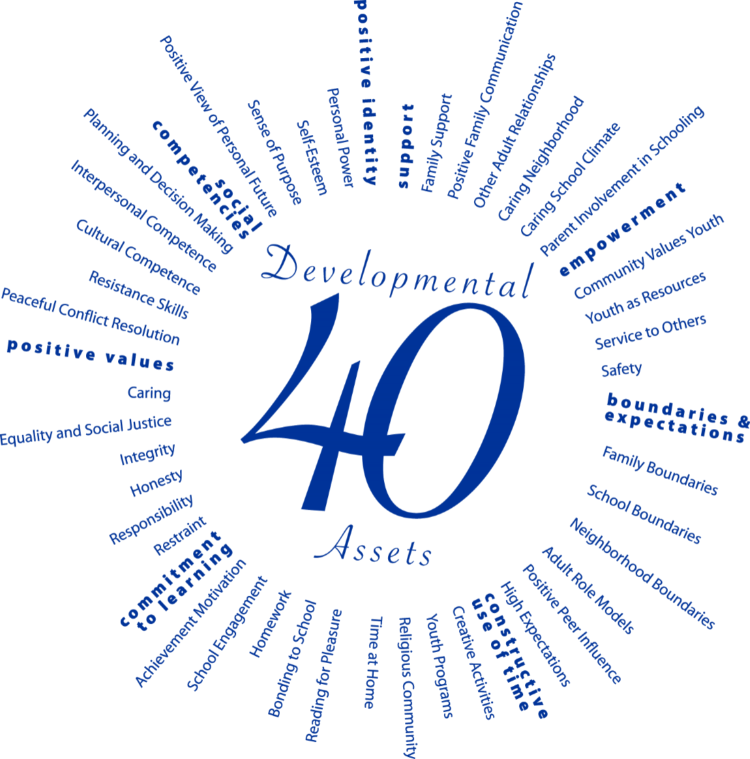
Developmental Assets
Developmental Assets help children grow into caring, engaged, and responsible adults. Developmental Assets include the internal character strengths and commitments young people need as well as the external supports and opportunities they need from their families, schools, organizations, and communities.
Search Institute introduced the framework in 1990 and, since then, has studied developmental assets in more that 5 million youth across North America and around the world. The approach focuses on young people’s strengths and working across the many parts of their lives to support their growth and successful development. Hundreds of schools, coalitions, and other organizations have used the developmental assets as a guiding framework for their youth development efforts. Source
Questions
WHAT IS IT?
Asset Building, Resiliency and Youth Development and are philosophies and strategies for creating youth-centered environments that prioritize the positive development of young people.
WHY USE IT?
Research and practitioner experience has proven that a positive school day and after school environment that intentionally develops youth’s assets and adopts a youth development approach can provide the experiences and skills that youth need to develop into healthy adults.
WHEN TO USE IT?
Utilizing an asset building, resiliency and youth development based approach is effective in planning and facilitating all aspects of school day and after school programs. The approach can be used:
As the foundation of your school’s philosophy to establish emotionally, physically safe and engaging learning environments; As a framework for creating engaging classroom, program structures and activities that offer meaningful participation, build skills and expose youth to new opportunities and resources; As an approach for increasing youth involvement and youth buy in to lesson and activity components; As a professional development component or part of a job orientation for all staff.
HOW IT IS USED:
Below are three philosophies of asset building, resiliency and youth development that are often referred to by school sites, local city agencies and community based organizations.
SFUSD- School Health Programs Department encourages the following Asset Building, Resiliency and Youth Development core principles for working with young people as measured by the California Healthy Kids Survey (CHKS):
Young people have the capacity to develop and transform as they move toward adulthood.
Young people are genetically intended to develop and are actively seeking to meet their own needs.
All young people need the same types of positive resources:
-Caring, Respectful Relationships
-High, Clear and Fair Expectations
-Meaningful Opportunities to Participate and Contribute
All young people need adults in their lives.
Source
PROCESS
First, the kids take a pretest called the DAP (Link). The school gets the results to help direct efforts to support students at their school based on the needs represented by the child responses. The school chooses activities to carry out throughout the year to intervene with the needs. Finally, a posttest of the DAP is given to measure the growth of the schools’ efforts to address the needs identified in the pretest DAP.
DAP QUICK REFERENCE
Length: 58 questions
Average Completion Rate:10 minutes
(Add at least 10 minutes for general instructions and collection.)
Youth: 4-12 grade; ages 9-18
Minimum youth needed for report: 30
Minimum time between Pre and Post: 3 months
Source


Need a Copy of the 40 Developmental Assets?
These documents are provided, compliments of the Search Institute. Click on the links to download PDF copies of 40 Developmental Assets lists for different developmental stages and in different languages.
These pages may be reproduced for educational, noncommercial uses only. Copyright © 1997, 2006 by Search Institute, 615 First Avenue N.E.,Suite 125, Minneapolis, MN 55413; 800-888-7828; search-institute.org. All Rights Reserved.
The following are registered trademarks of Search Institute: Search Institute®, Developmental Assets® and Healthy Communities • Healthy Youth®.
Asset Checklist
Assets for Different Developmental Stages
Assets in Alternate Languages
Please note, these asset lists were compiled by Healthy Communities, Healthy Youth sites across the United States. They represent volunteer efforts. Assets lists in alternate stages for different developmental levels are not available for every language.
Would you like to learn more about the Search Institute and their work with the 40 Developmental Assets? Click here to check out their website!







